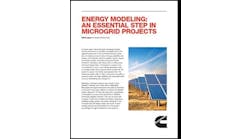We worry about the big calamities like hurricanes and cyberattacks that cause long power outages. But let’s face it, for most of us momentary outages are more likely to disrupt our daily lives.
Mike Edmonds, chief commercial officer, S&C Electric
Mike Edmonds, chief commercial officer for S&C Electric, thinks about this when his 5-year-old son calls out: “Alexa, bedtime story!”
Raised on tech devices, his child’s generation will grow up even less tolerant of power outages, even brief blinks, than their predecessors. Alexa needs her electricity.
Unfortunately, the US already experiences the highest number of power outages among developed economies, according to the Council of European Energy Regulators.
And the threat of outages grows as the grid becomes increasingly “fragile,” Edmonds said.
This fragility does not stem from a design flaw, but from asking the grid to perform beyond its original specifications.
“The way energy is being produced and consumed has locationally changed as well as characteristically changed,” Edmonds said, in a recent interview with Microgrid Knowledge, leading up to Microgrid 2019.
Widespread use of renewable energy — which generates power, or not, depending on the weather — was not contemplated as the grid was built over the last century. Nor was today’s two-way flow of power. Electricity no longer moves only from grid to customer, but also moves from customer to grid with the rise of on-site energy.
Learn about Hawaii’s first 100% renewable industrial microgrid during a special session by S&C Electric at Microgrid 2019, May 15 in San Diego
“People want a 100 percent renewable grid and 100 percent reliable power,” said David Chiesa, senior director – global business development, non-wire alternatives, for S&C Electric. “Up until this point those two things haven’t been compatible.”
Canary in a coal mine
As more states pursue a goal of using 100% renewable energy, utilities must look closely at how to manage issues that arise, such as voltage stability. On April 22, Nevada became the most recent state to set a 100% goal by 2050. Puerto Rico is on board for 100% renewables by 2050 too. California seeks 100% zero-carbon electricity by 2045. Other states are looking at similar goals.
But it is Hawaii that’s most interesting, said Edmonds. The state jumped ahead of others when it became the first state to kick off a 100% goal in 2015. Hawaiian Electric reported in February that it’s on its way. More than a quarter of its power now comes from renewables and peak renewable production ranges from 54 to 80% on the islands it serves. Hawaii also has the highest penetration of customer-owned photovoltaic systems in the country.
“The grid there is actually, engineering wise, physically changing,” Edmonds said.
Hawaii’s early and aggressive renewable energy goals — coupled with its isolation from larger grids — makes the state one to watch, what Edmonds calls a “canary in a coal mine.”
The bird on non-wires alternatives
To avert electricity shortfalls, the power industry traditionally pursued big infrastructure projects, such a large-scale transmission lines to ship in more power. Edmonds advocates a different approach. He sees the answer in targeted, distribution level improvements known as non-wires alternatives, which often take the form of microgrids, energy efficiency and other distributed energy resources.
In Hawaii, for example, Hawaiian Electric is pursuing an integrated grid plan (IGP) that encompasses non-wires alternatives. The plan’s premise is that the “grid we have is not the grid we want.”
Utilities install non-wires alternatives to deter or avoid the expense of large infrastructure projects. One of the most well-known non-wires alternative projects is Consolidated Edison’s Brooklyn-Queens Demand Management Program, designed to spend $200,000 million on non-wires alternatives to avert spending $1 billion on a new substation.
An old company’s work on a new grid
Non-wires alternatives can lead to a 30% improvement in energy efficiency and demand flexibility and avoid $17 billion in distribution costs through 2030, according to “The Non-Wires Solutions Implementation Playbook” by the Rocky Mountain Institute.
Not surprisingly, utilities are taking notice. The Smart Electric Power Alliance found that more than half of the 150 utilities it surveyed in 2018 were interested in non-wires alternatives.
For companies like S&C Electric, which has been providing equipment and services to the grid since 1911, non-wires alternatives offer an opportunity to do what they’ve been doing all along — make electricity more dependable — but with a new twist as renewables and tech alter how we produce and use energy.
“Think of us as a modern grid enabler,” Edmonds said.
Learn more about non-wires alternatives at Microgrid 2019: Shaping the New Electric Grid, May 14-16 in San Diego, Calif.








